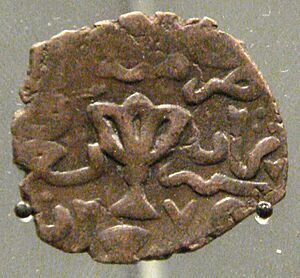Barquq facts for kids
Quick facts for kids Barquq |
|
|---|---|

Inside the Mosque-Madrasa of Sultan Barquq
|
|
| Sultan of Egypt and Syria | |
| First reign | 1382–1389 |
| Predecessor | As-Salih Hajji |
| Successor | As-Salih Hajji |
| Second reign | 1390–1399 |
| Predecessor | As-Salih Hajji |
| Successor | An-Nasir Faraj |
| Born | c. 1336 Kasa, Circassia |
| Died | 20 June 1399 (aged c. 63) |
| Spouse |
|
| Issue |
|
| Religion | Sunni Islam |
Al-Malik Az-Zahir Sayf ad-Din Barquq (born around 1336) was an important ruler in Egypt and Syria. He was the first Sultan of the Circassian Mamluk Burji dynasty. He ruled twice, first from 1382 to 1389, and then again from 1390 to 1399.
Barquq was born in Circassia, a region near the Black Sea. He was brought to Egypt as a young man. He eventually became a powerful leader among the Mamluks. He took the throne from Sultan al-Salih Hajji. Barquq placed many of his family members in important jobs. After a short time when another sultan ruled, Barquq got his throne back. He ruled until he died in 1399. His son became the next sultan.
Contents
Early Life and Rise to Power
Barquq was from Circassia. He was brought to Egypt as a young man. In Egypt, he became a Mamluk. Mamluks were special soldiers who were often bought as young men and trained to be loyal fighters and leaders. Barquq joined the household of a powerful Mamluk leader named Yalbugha al-Umari around 1363.
Barquq became very influential in the Mamluk government. In 1381, he brought his father to Egypt. His father, who was originally Christian, became a Muslim. This was unusual because most Mamluk fathers were not Muslim. Barquq's father was given a high military rank. He was known for being kind and generous.
For many years, the Mamluk empire was ruled by weak sultans. These rulers were often very young. They were like puppets, controlled by different Mamluk groups. In 1377, the sultan was overthrown. His seven-year-old son became the new ruler. When that boy sultan died, his younger brother took the throne.
Barquq was part of a powerful group that controlled these young sultans. He gained more and more power. In November 1382, he removed Sultan al-Salih Hajji from the throne. Barquq then became the sultan himself. He chose the name al-Zahir, which means "the Victorious."
First Reign (1382–1389)

During his first time as sultan, Barquq gave many important jobs to his family members. This helped him to stay in power. He also supported the building of the Mosque-Madrasa of Sultan Barquq in Cairo. This large building was finished in 1386. It was a place for prayer and learning. It is still one of the most famous Islamic buildings in Cairo.
Barquq also stopped a public holiday in Egypt. This holiday celebrated the Coptic New Year.
The famous Khan El-Khalili market in Cairo was also started during his rule. It was built by one of his trusted leaders.
Revolt and Return
In 1389, two Mamluk governors from northern Syria rebelled against Barquq. They were named Mintash and Yalbogha al-Nasiri. They took control of Syria and then marched towards Cairo. Barquq tried to escape but was caught. He was sent away to a castle.
The two governors put Sultan Hajji back on the throne. But soon, fighting broke out among the Mamluk groups in Cairo. Barquq's supporters won these fights. Barquq was able to return to Cairo in February 1390. He became sultan again.
Second Reign (1390–1399)

During his second time as sultan, Barquq made sure that almost all the governors and high officials were people loyal to him. He became an enemy of a powerful warlord named Timur. Timur had invaded Baghdad in 1393 and planned to invade Syria. Because of this, Barquq made an alliance with the Ottoman Empire after 1393.
Barquq died in June 1399. His son, Nasir-ad-Din Faraj, became the next sultan. Barquq was buried in a special tomb built by his son in Cairo.
Legacy
Sultan Barquq's time as ruler also involved trade with other countries. Old coins from Barquq's reign have been found in modern-day Somalia. These coins were made in Cairo or Damascus. They show that there was trade between Egypt and the Adal Sultanate in East Africa. Many of these coins are now kept in the British Museum in London.
See also
- List of rulers of Egypt
- Sayyid Husayn Ahlati

